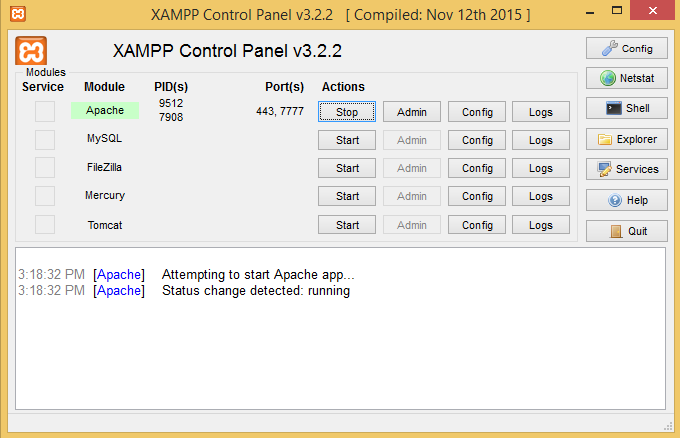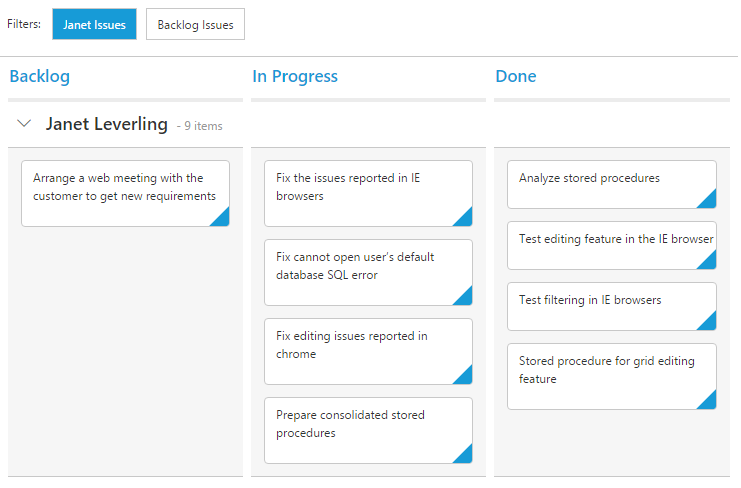Getting Started with PHP Kanban
6 Jun 202317 minutes to read
To get start with the Kanban control using PHP wrapper classes, either of the following prerequisites needs to be installed in your machine to deploy and run those samples locally.
In this section, let’s see how to create, deploy and run the Kanban samples using Xampp server.
Creating a Sample Folder
Usually, the Xampp gets installed in C:\ drive. Now, create a new sample folder namely KanbanPHP within C:\\xampp\\htdocs and place all the below mentioned folders within it.
- Scripts - Includes all the script files necessary to render the control. [Optional, if cdn links are used in the sample]
- CSS - Includes all the required stylesheet files. [Optional, if cdn links are used in the sample]
- PHP Class Libraries - Includes the individual PHP wrapper class files for all the controls. [Mandatory]
- Sample PHP file (with .php extension). [Mandatory]
Adding Scripts and CSS files
The required scripts and CSS files can be copied into the above created sample folder namely KanbanPHP and then can be manually referred on the sample page or else the cdn links can be referred directly. In case, if you are manually referring the scripts and CSS files in your PHP sample, refer this topic to know how to copy the required scripts and CSS from the installed location.
Adding PHP Class libraries
Copy the PHP class libraries into your sample folder, which are the collection of PHP wrapper files created individually for all the controls in order to access and process its server-side values and then send it back to the client-side. These libraries are available within the following installed location -
- (Installed Location)\Syncfusion\Essential Studio\28.1.33\PHP\Src
Create a PHP file
Create a first PHP file in Xampp and name it appropriately with .php extension and also place it under the newly created sample folder KanbanPHP. For example, say Index.php with the initial code as shown below -
<!DOCTYPE html>
<html>
<head>
<title>Getting Started - Kanban</title>
<!--Dependency files references-->
</head>
<body>
<?php
?>
</body>
</html>Scripts and CSS references
Refer the required scripts and CSS files in your PHP page as mentioned below in order to render the Kanban control -
<!DOCTYPE html>
<html>
<head>
<title>Getting Started - Kanban</title>
<link href="http://cdn.syncfusion.com/28.1.33/js/web/flat-azure/ej.web.all.min.css" rel="stylesheet" />
<link href="http://cdn.syncfusion.com/28.1.33/js/web/responsive-css/ej.responsive.css" rel="stylesheet" />
<script src="http://cdn.syncfusion.com/js/assets/external/jquery-3.0.0.min.js"></script>
<script src="http://cdn.syncfusion.com/js/assets/external/jsrender.min.js"></script>
<script src="http://cdn.syncfusion.com/28.1.33/js/web/ej.web.all.min.js"></script>
</head>
<body>
<?php
?>
</body>
</html>Here, the CDN links are used. In case, if the individual scripts are required to render the Kanban control, refer here.
AutoLoad file reference
Include the PHP AutoLoad file reference within the body section of the PHP page.
<!DOCTYPE html>
<html>
<head>
<title>Getting Started - Kanban</title>
<link href="http://cdn.syncfusion.com/28.1.33/js/web/flat-azure/ej.web.all.min.css" rel="stylesheet" />
<link href="http://cdn.syncfusion.com/28.1.33/js/web/responsive-css/ej.responsive.css" rel="stylesheet" />
<script src="http://cdn.syncfusion.com/js/assets/external/jquery-3.0.0.min.js"></script>
<script src="http://cdn.syncfusion.com/js/assets/external/jsrender.min.js"></script>
<script src="http://cdn.syncfusion.com/28.1.33/js/web/ej.web.all.min.js"></script>
</head>
<body>
<?php require_once 'EJ\AutoLoad.php'; ?>
</body>
</html>Create a Kanban
Create the Kanban control object by accessing the Kanban namespace EJ\\Kanban using new keyword. Define its properties and then output the Kanban control by echoing the result object.
<body>
<?php
require_once 'EJ\AutoLoad.php';
$kanban = new EJ\Kanban("defaultKanban");
$column = new EJ\Kanban\Column();
$column ->headerText("Backlog");
$column1 = new EJ\Kanban\Column();
$column1 ->headerText("In Progress");
$column2 = new EJ\Kanban\Column();
$column2 ->headerText("Done");
$columns = array(
$column,$column1,$column2
);
echo $kanban ->columns($columns)->render();
?>
</body>NOTE
2.It is mandatory to define the render() method at last as given in the above syntax, in order to display the Kanban on the browser.
Data Binding
Data binding in the Kanban is achieved by using the ej.DataManager that supports both RESTful JSON data services binding and local JSON array binding. To set the data source to Kanban, the dataSource property is assigned with the instance of the ej.DataManger.
For demonstration purpose, Northwind OData service is used in this tutorial. Refer to the following code example.
<body>
<?php
require_once 'EJ\AutoLoad.php';
$dataManager= new EJ\DataManager();
$dataManager->url('http://mvc.syncfusion.com/Services/Northwnd.svc/Tasks')->offline(false);
$kanban = new EJ\Kanban("defaultKanban");
$column = new EJ\Kanban\Column();
$column ->headerText("Backlog");
$column1 = new EJ\Kanban\Column();
$column1 ->headerText("In Progress");
$column2 = new EJ\Kanban\Column();
$column2 ->headerText("Done");
$columns = array(
$column,$column1,$column2
);
echo $kanban ->columns($columns)->dataSource($dataManager)->render();
?>
</body>NOTE
ODataAdaptor is the default adaptor used within DataManager. While binding to other web services, proper data adaptor needs to be set for
adaptoroption of DataManager.
Mapping Values
In order to display cards in Kanban control, you need to map the database fields to Kanban cards and columns. The required mapping field are listed as follows
-
keyField- Map the column name to use askeyvalues to columns. -
columns- Map the correspondingkeyvalues ofkeyFieldcolumn to each columns -
content- Map the column name to use as content to cards withinFieldobject. -
primaryKey- Map the column name to use as primary Key withinFieldobject.
<body>
<?php
require_once 'EJ\AutoLoad.php';
$dataManager= new EJ\DataManager();
$dataManager->url('http://mvc.syncfusion.com/Services/Northwnd.svc/Tasks')->offline(false);
$kanban = new EJ\Kanban("defaultKanban");
$column = new EJ\Kanban\Column();
$column ->key("Open")->headerText("Backlog");
$column1 = new EJ\Kanban\Column();
$column1 ->key("InProgress")->headerText("In Progress");
$column2 = new EJ\Kanban\Column();
$column2 ->key("Close")->headerText("Done");
$fields = new EJ\Kanban\Field();
$fields ->content("Summary")->primaryKey("Id");
$columns = array(
$column,$column1,$column2
);
echo $kanban ->columns($columns)->dataSource($dataManager)->fields($fields)->keyField("Status")->render();
?>
</body>NOTE
primaryKeyfield is mandatory for “Drag and Drop” ,”Selection” and “Editing” Features.
Enable Swimlane
Swimlane can be enabled by mapping the swimlaneKey of Field object to appropriate column name in dataSource. This enables the grouping of the cards based on the mapped column values.
<body>
<?php
require_once 'EJ\AutoLoad.php';
$dataManager= new EJ\DataManager();
$dataManager->url('http://mvc.syncfusion.com/Services/Northwnd.svc/Tasks')->offline(false);
$kanban = new EJ\Kanban("defaultKanban");
$column = new EJ\Kanban\Column();
$column ->key("Open")->headerText("Backlog");
$column1 = new EJ\Kanban\Column();
$column1 ->key("InProgress")->headerText("In Progress");
$column2 = new EJ\Kanban\Column();
$column2 ->key("Close")->headerText("Done");
$fields = new EJ\Kanban\Field();
$fields ->content("Summary")->primaryKey("Id")->swimlaneKey("Assignee");
$columns = array(
$column,$column1,$column2
);
echo $kanban ->columns($columns)->dataSource($dataManager)->fields($fields)->keyField("Status")->render();
?>
</body>Adding Filters
Filters allows to filter the collection of cards from dataSource which meets the predefined query in the filters collection. To enable filtering, define filterSettings collection with display text and ej.Query.
<body>
<?php
require_once 'EJ\AutoLoad.php';
$dataManager= new EJ\DataManager();
$dataManager->url('http://mvc.syncfusion.com/Services/Northwnd.svc/Tasks')->offline(false);
$kanban = new EJ\Kanban("defaultKanban");
$column = new EJ\Kanban\Column();
$column ->key("Open")->headerText("Backlog");
$column1 = new EJ\Kanban\Column();
$column1 ->key("InProgress")->headerText("In Progress");
$column2 = new EJ\Kanban\Column();
$column2 ->key("Close")->headerText("Done");
$fields = new EJ\Kanban\Field();
$fields ->content("Summary")->primaryKey("Id")->swimlaneKey("Assignee");
$columns = array(
$column,$column1,$column2
);
$filterQuery = new EJ\Query();
$filterQuery->where("'Assignee','equal','Janet Leverling'");
$filterQuery1 = new EJ\Query();
$filterQuery1->where("'Status','equal','Open'");
$filter = new EJ\Kanban\FilterSetting();
$filter->text("Janet Issues")->query($filterQuery)->description("Displays issues which matches the assignee as Janet Leverling");
$filter1 = new EJ\Kanban\FilterSetting();
$filter1->text("Backlog Issues")->query($filterQuery1)->description("Display the issues of 'Backlog'");
echo $kanban ->columns($columns)->dataSource($dataManager)->fields($fields)->filterSettings(array($filter,$filter1))->keyField("Status")->render();
?>
</body>Running the PHP file
The above created sample is now ready to run. Therefore, open the XAMPP control panel and start the Apache module as shown in the below image -

Now, the sample can be run directly on the browser through localhost with appropriate port numbers, on which the Apache server is currently listening. For example, say if the Apache is configured to listen on port 7777, then type http://localhost:7777/ on your browser and press enter. Also, make sure that your sample folder is present within this location C:\\xampp\\htdocs as mentioned earlier.
The following Kanban output shows up on the browser, when you type http://localhost:7777/KanbanPHP/index.php and press enter -

NOTE
In case, if you face any problem with default port 80 while running your sample, make the Apache to listen on some other different ports. The port number changes needs to be done on both the
httpd.confandhttpd-ssl.conffiles, in order to get rid of this problem.(Refer here)